This article will explain the full itemised costs to fit a high performance MVHR system in a new build or renovated home in the UK.
It has now been updated for 2025 prices based on our cross-industry experience of specifying hundreds of MVHR systems over the last few years. Prices have settled across the board, and we’re even seeing a few reductions in some cases.
How much does an MVHR system cost in total?
For headline figures based on our cross-industry data:
- A 150m2 home will cost £5,267 ex VAT to design, supply and commission a high performance Zehnder, BRINK or Lindab MVHR system. Installation by a third party team would cost £2.7k for 150m2, but we also support self-installers to DIY install and save money.
- A 250m2 home will cost £6,769 ex VAT for design, supply and commissioning, and £3.5k for installation.
- A 350m2 home will cost £8,254 ex VAT for design, supply and commissioning, and £4.6k ex VAT for installation.
I’ve been updating this article every year since 2016 now. There is a lot of variance in pricing so now I’ll explain each cost in more detail.
Please note, these costs are for incredibly quiet MVHR systems using high quality units and materials – we never use PVC ducting or flexi-duct as it can cause acoustic and air quality issues. Read more on the problems with cheap MVHR units here.
VAT on MVHR
VAT on MVHR is typically standard-rated at 20 per cent, but it can be zero VAT rated if a new build (upfront or reclaimable) or 5 per cent VAT if a vacant property. VAT criteria is complicated so contact us directly if needed.
The highest-quality units we recommend recover around 93-96 per cent of the heat you’ve already generated in your home and transfer that heat to the incoming fresh air from outside in winter, so they’re also very economical.
This article will provide itemised average pricing for 2025 prices, but if you would prefer a free MVHR sizing and specification for your own build project please complete our quick form here and we’ll send you a full proposal bespoke to your home.
How much does designing an MVHR system cost?
First step, you will need a design of the MVHR ducting layout routes around the home. Designing an MVHR system in a 150m2 semi-detached home with perhaps one bathroom, two ensuites and three or four bedrooms will cost approximately £496 ex VAT for a full detailed ductwork design service schematic.
Be wary of “free” MVHR designs – they are often rushed and cause issues with the trades on site during the build, eg, by missing structural conflicts such as steel beams that the builder later has to either duck under (“boxing in) or drill through, adding costs for labour and reducing structural integrity. A paid-for designer will spend time working out ways to move around structural elements without boxing in or drilling through unless necessary.
MVHR suppliers offering “free” designs often also hide the actual design costs by using cheaper materials in the supply costs to increase their profit margin.
For our design team it takes minimum one and up to six weeks to design a proper residential MVHR system from scratch, and our design team will usually request:
- structural and architectural layout drawings (in pdf) – or even paper sketches will do;
- guidance on any lowered ceilings, risers or voids;
- electrical layout diagrams, if available (so room valves don’t conflict with lighting layouts)
If you only have hand-drawn sketches of the property, we can still make our designs work.
When should I design my MVHR / HRV system?
MVHR duct design should be done early enough in your build programme that the ducting can be installed before first fix plumbing and electrical services. Planning / Building Regulations stage is best.
This is because every extra bend or turn in your MVHR ducting layout will increase air disturbance, which could lead to a noisier system. Hence, diverting wiring or plumbing is a much better idea than diverting ducting. Good MVHR designers like ourselves will minimise the number of duct bends, but that’s no good if you get on site and the plumber has already blocked off all of your service runs.
Luckily, we can design MVHR systems within one to six weeks, so don’t worry if you’re worried that you’ve left it too late. Our supply team can have the materials on site ready within a week, too.
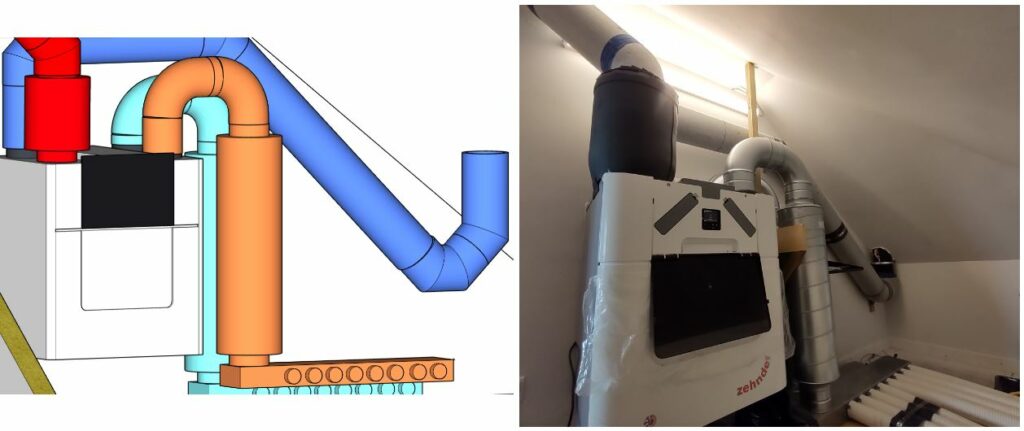
How much do good MVHR units cost?
A top quality MVHR unit from Brink or Zehnder (the premium Passivhaus-Institute accredited models with the easiest maintenance, best controls and quietest fan motors) will cost between £1,500 ex VAT to £3,500 ex VAT depending on whether you require a BRINK 325 or 400, or a Zehnder CA200, Q350, Q450 or the largest Q600 MVHR unit.
Although inflation has raised prices across the board for MVHR units and materials our prices are still typically about 40 per cent less than other online ventilation retailers.
An MVHR unit should include as standard:
- a touch panel (either in-built or as a separate control), so you can programme and commission the unit;
- frost protection, so cold wintry air doesn’t damage the unit
- automated summer bypass capabilities, so that when it’s hot outside the heat recovery element turns itself off to help with cooling the air
- EC centrifugal motors, the quietest and most efficient on the market
- G4 and/or F7 filters
If you want more from your MVHR there are lots of additional extras:
- Comfort cooling, a small addition to the MVHR unit with a cooling feature on the supply air ducting for hot days. Adding cooling to an MVHR costs £3,600 ex VAT for the ComfoClime as of 2025. Please also consider around labour and materials for wrapping the supply ducts in closed-cell insulation.
- An enthalpy exchanger, which helps to maintain moisture levels in the home in winter when the air is dry would cost an additional £190 +VAT with the standard Zehnder Q unit as of 2025.
- A ComfoPost, which links a chiller coil in the MVHR duct to a reversible air or ground source heat pump, costs around £900 ex VAT, but can provide a significant amount of cooling
- Plus much, much more – please contact me if you have any questions.
Ordering early in the project is advised to ensure the unit arrives in good time.
How much do MVHR ducting, valves, manifolds and silencers cost?
In 2025, ducting and all materials for the entire MVHR system for a high performance 150m2 home will cost approx. £2,313 ex VAT. For smaller homes, this will be more economical.
Although prices have been discounted in recent years, we’ve seen a general trend of inflation amongst MVHR product costs from the best suppliers, so the earlier you can source your MVHR system, the better.
For a 250m2 home, ducting and all materials for the HVAC system will cost approx. £3,118 +VAT.
For a 350m2 home, ducting and all materials will cost approx. £4,063 ex VAT.
However, there are a number of variables to consider that can lower the price:
- The layout of the home – how tricky is it to run ducting?
- Will steel or semi-rigid HDPE radial ducting be used?
- Is the ducting going into tight ceiling voids? Proprietary plastic oval rigid ducting for smaller voids is a bit more expensive
- Will your system be designed as a radial system or a branch system? Ie, will each valve run come from the MVHR unit through a manifold, or will you have a single main duct run for each supply or extract length, with each room branching off? Radial systems save money on sound attenuators because you don’t need as many.
Be wary of MVHR suppliers who offer a low price for materials but fail to include sound drum attenuators (silencers) in their pricing – drum attenuators are vital to dealing with noise, but they are expensive, so less scrupulous MVHR suppliers may “forget” to add them in the cost so that their materials quote seems cheaper – but the sound attenuation will be missed once the MVHR is running…
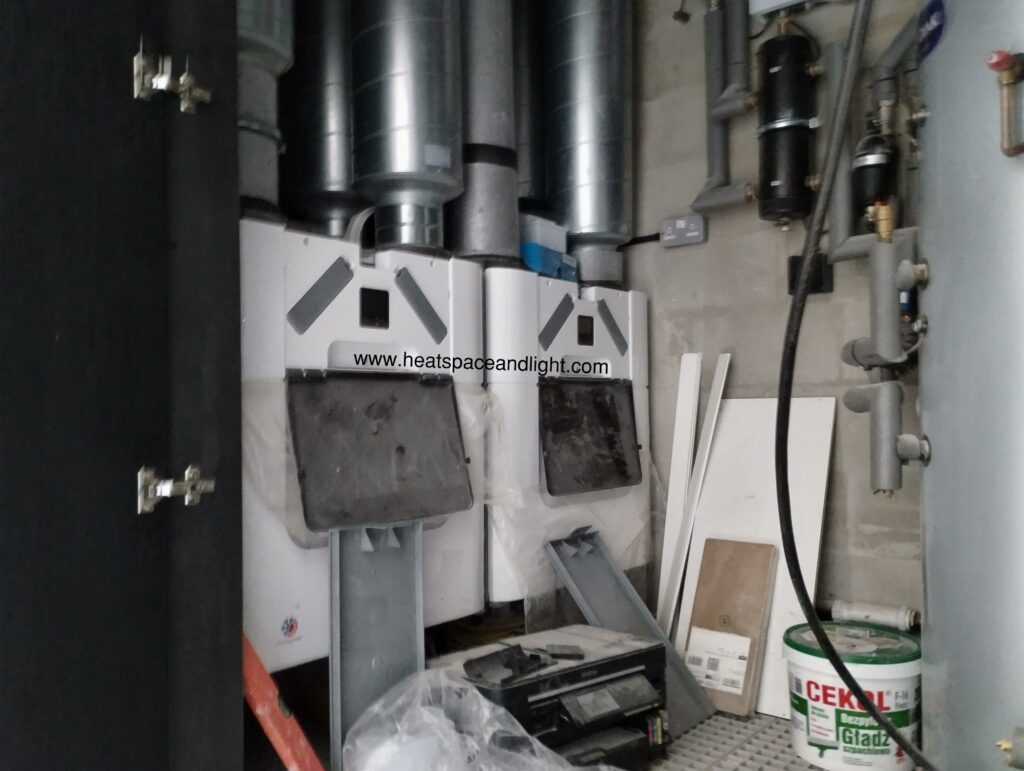
Also be wary of suppliers who use flexible duct and flexible silencers in their system – these are not the same as steel drum attenuators. Flexible silencers cost pennies to make but don’t offer anywhere near the same acoustic deadening, plus they can crush and tear easily, reducing performance.
If the supplier is also offering a cheaper unit and a “free” design it means the sound risk is seriously elevated – so additional sound attenuation is a must.
You also need to consider closed-cell insulation, room valves (plastic or steel? Fancy or plain?), condensate traps, strapping, plenums, manifolds, o-rings, spiral steel ducting, external grilles or cowls, strap-banding, screws and boost controls (and any associated wiring costs – unless it’s a Wifi version).
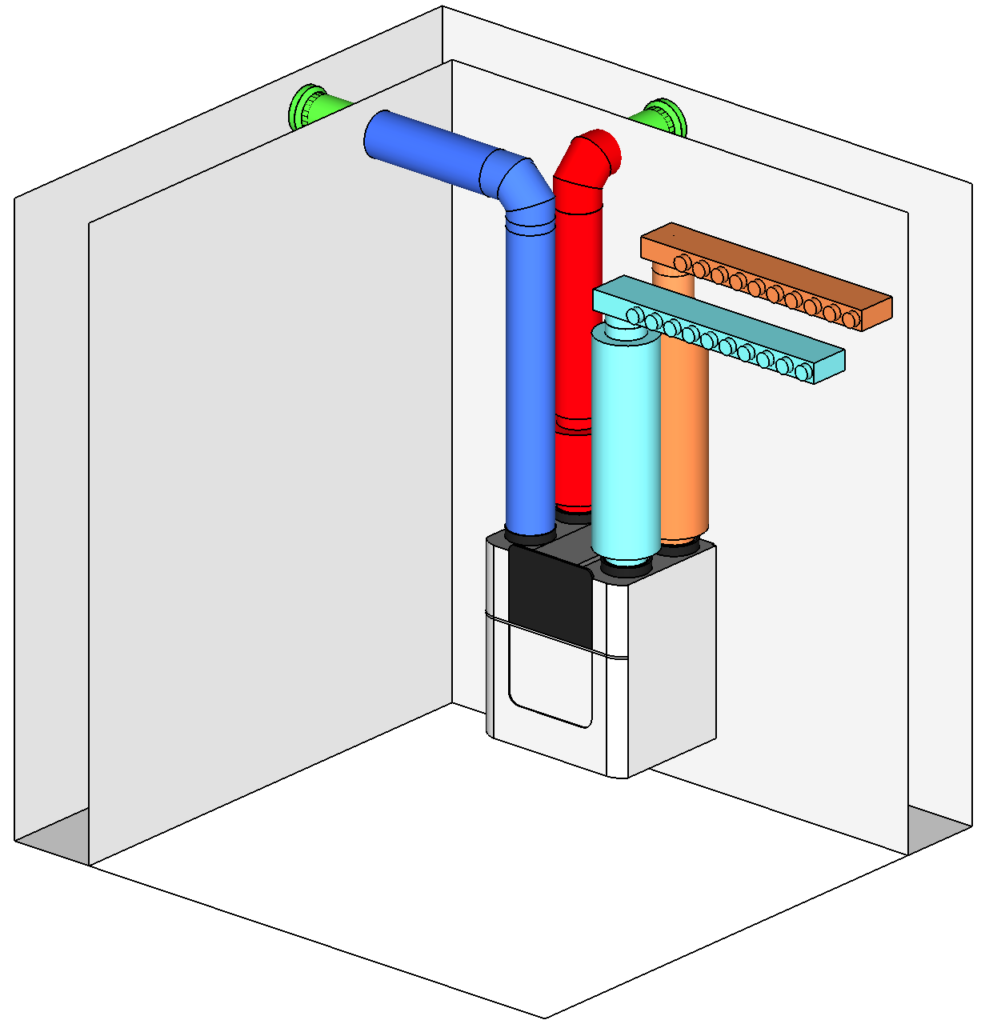
How much to install an MVHR system in the UK?
Installing an MVHR or HRV system via a professional team will cost roughly:
- £2,730 ex VAT for a 150m2 home;
- £3,510 ex VAT for a 250m2 home and;
- £4,290 ex VAT for a 350m2 home.
We offer a free guided self-installation service and we’ve had lots of success helping homeowners save thousands of pounds on installation.
Our team can help you save money by guiding a self- or DIY-installation by your builder or tradesperson, as our radial ductwork system is exceptionally straightforward to install – particularly using our easy-to-follow design report documents and dedicated advice. Most of the ducting works can be done with basic tools, with only the steel ducting to be cut with an angle grinder and drill, and core drilling potentially for the external Intake/Exhaust outlets.
For you or your builder, a radial MVHR system self-installed rather than by a HVAC contractor can save a lot of money on install costs – and the performance is superb.
Professional MVHR installers will normally request that all of the ceilings are open and that building works (creating inlet/outlet holes for ducting) is already completed – by your contractor usually.
Installing an MVHR system will take a few capable installers about three to five days. First fix is done ahead of first fix plumbing and electrics, with everything set in place up to the valves. Second fix can be done post-decoration, and commissioning will follow.
Be wary of unknown installers, as quality can vary significantly even amongst the “professional” HVAC installers. We can recommend MVHR installers that we know are competent and fairly-priced – feel free to ask us via our contact page.
Every MVHR design we produce we also commission, balance and hand over, plus we perform a 36-point quality check post-installation to make sure it’s been installed correctly.
We also hold MVHR toolbox talks on the building site for new installers if they’re keen to understand the MVHR system before they start.
How much does it cost to balance and commission an MVHR system?
Commissioning an MVHR system costs £460 ex VAT for the average 150m2 home. For a 250m2 home it’s £531 ex VAT, and for a 350m2 home it’s £640 ex VAT.
Commissioning is a crucial aspect of installing an MVHR system.
An uncommissioned MVHR is like an untuned piano. We need to ensure the airflow is balanced to each room to run quietly and efficiently.
Your Building Control Officer will also want to see a certificate of performance for practical completion of building works.
It’s also our chance to quality check the system, and we have 36 points of reference to assess.
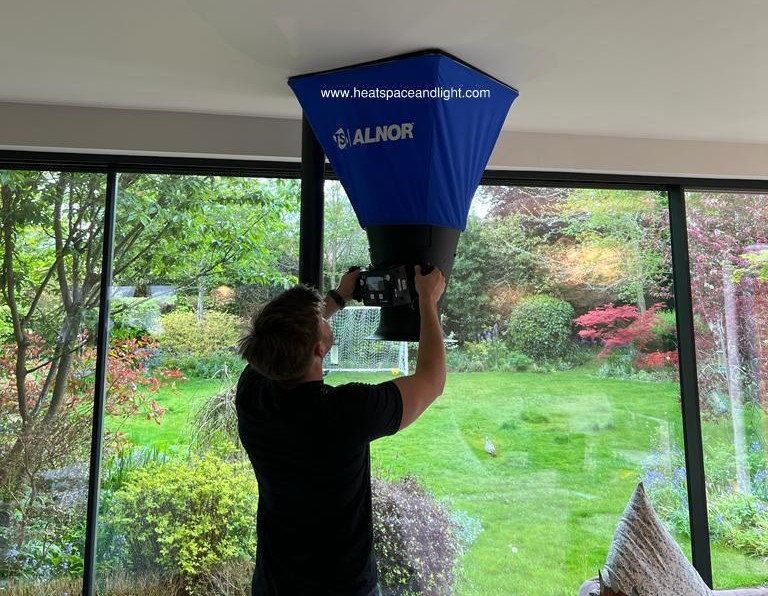
Beware those MVHR suppliers who either don’t offer commissioning, or don’t convey its importance – the fine tuning at the commissioning stage is vital to ensure the MVHR system works properly – and it’s not easy to do without calibrated equipment for measuring airflow.
Your MVHR designer will have assigned airflow rates to each individual room in your property at a set rate based on a number of factors, the most important of which will be ensuring the property meets Building Regulations Part F and Passive House standards for healthy airflow.
For example, kitchens need to extract a minimum of 46 cubic metres of airflow per hour in “boost” mode to deal with the smells, heat and moisture that’s created from cooking and socialising.
Commissioning and reporting on the MVHR system will take a competent technician a full day using a calibrated balometer. If they find significant leaks or they need to come back for any reason (because the unit isn’t functioning, for example), you may be billed again for the return – but with our systems, it’s rare we have to return.
Finally when we commission the system we also produce your Ventilation Certificate for Building Control compliance.
Six year warranty on the best MVHRs
A properly designed and commissioned MVHR will guarantee healthy, fresh, filtered air throughout your home, working silently in the background, for more than 25 years ideally. Our MVHR systems come with a six year warranty, and F7 filters cost around £26 ex VAT a year to change.
Finally, how much does an MVHR system cost to run annually?
Our MVHR units use the best fans on the market and only cost pennies per day in electricity to run.
This photo taken from our commissioning site visit shows an MVHR unit using 16W of electrical power to take outdoor air from 1.5 DegC to 22 DegC.
That’s less than 0.5kWh per day to provide fresh, healthy air all year round.
It costs approx.£15 – £40 per year in electricity to run an MVHR system constantly, but you might save a lot more than that on heating bills because it is recovering up to 90 per cent of the heat that would normally be lost to leaks and draughts in the building fabric.
The payback rate for an MVHR system (aside from all of the comfort and health benefits of having fresh, filtered air at an even temperature all year round) could be 15 years or less – that’s actually a better payback than solar panels whilst also providing increased comfort and healthy indoor air.
Contact us for a free MVHR proposal
Hopefully this has helped with your budgeting, but if you would like a firmer itemised quotation please contact us here with your project details.
Finally, here’s a video of one of our MVHR systems, and how quietly it runs when properly designed, supplied and commissioned by our team:

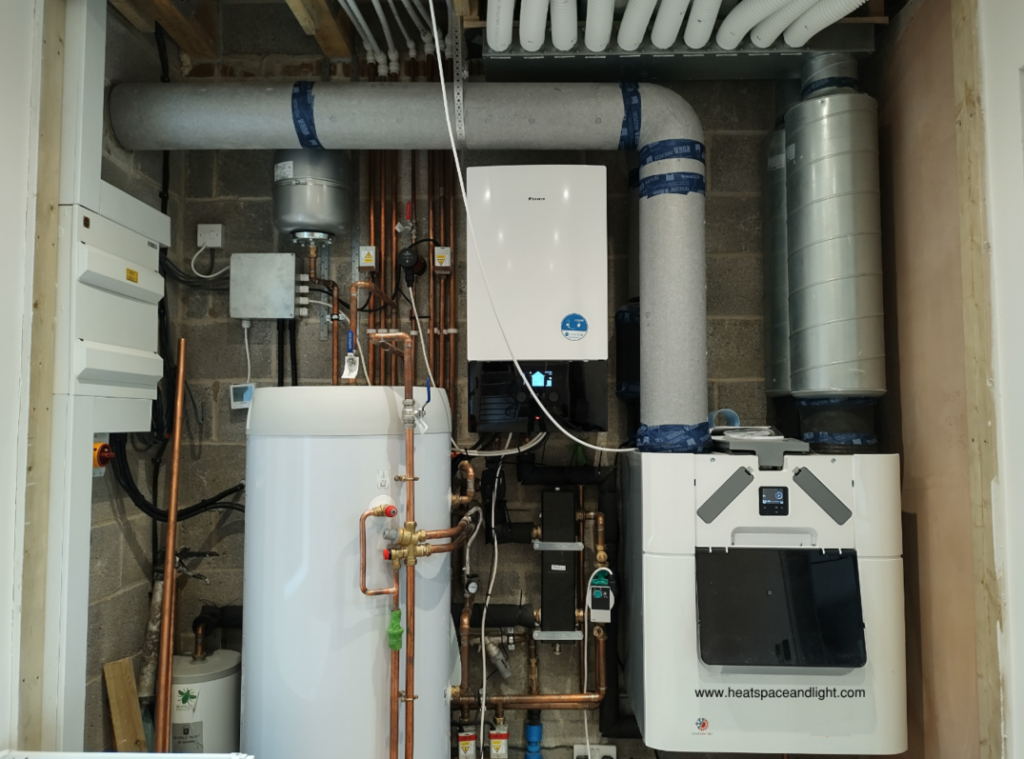
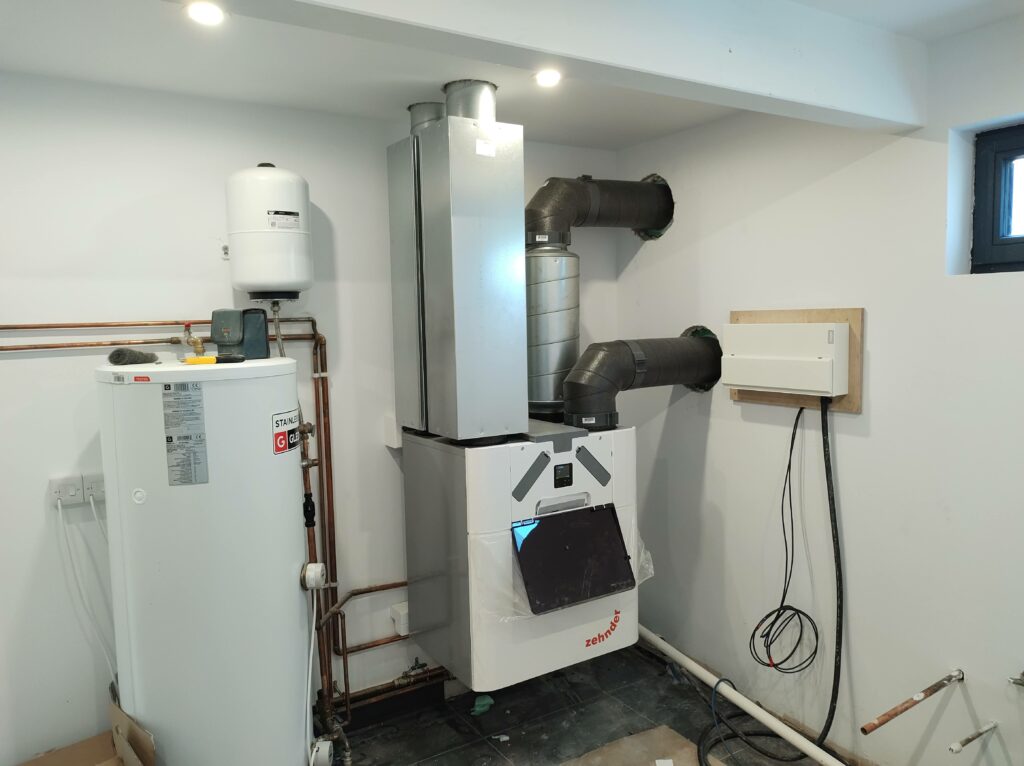
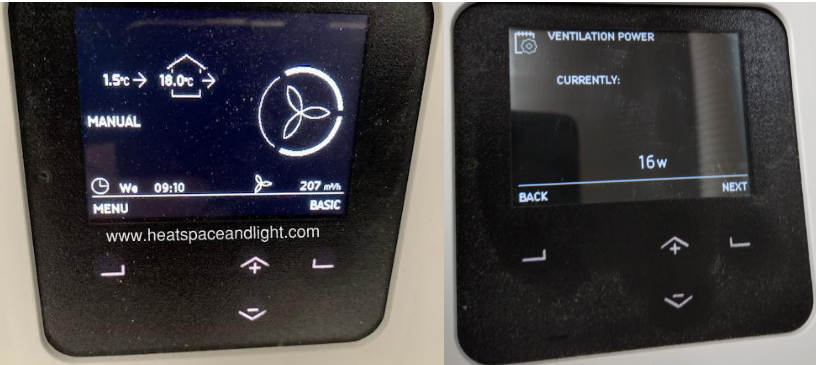
Thank you for sharing such an interesting post about heat recovery ventilation system
Regards
Joe Richard
Great article. Does this mean you no longer need an extractor in the kitchen? Surely food smells will still linger in no extractor fan/hood is fitted?
Hi Tam,
Kitchen cooker hoods are still needed because they deal with airborne grease that’s produced when cooking or frying. It’s best that the cooker hood deals with this because grease in the MVHR ducting would gradually clog it.
The MVHR, because it is extracting air from the kitchens constantly at approx/ 42m3hr is actually the best way to get rid of cooking smells – within an hour or two the cooking smells will be completely exhausted outside by the MVHR and replaced with fresh supply air.
If you have any more questions about MVHR or ventilation please let me know – I’m happy to help.
Best wishes,
Patrick
Hi there. We are completely refurbishing the upper floor of our house.
5 bedrooms
1 family bathroom
2 ensuites
The house is reasonably air tight but I don’t know what the actual value is.
Nely installed double glazed windows etc
1990 build but built to a high standard.
All the ducting and units can be installed in the loft.
Worth installing to the first floor area only to manage extract from bathrooms and ventilation?
Thanks for any advice
Hi Andrew,
If the house is reasonably airtight already then it’s likely your refurbishment will improve it to the extent that some form of mechanical ventilation will be necessary for healthy air quality, so it’s good you’re considering it.
One option is to run all of the ducting in the loft for the first floor as you say, but if we can also find a small amount of space in stud walls or in a riser to drop three or four 75mm diameter ducts we’ll be able to ventilate the ground floor also – and that will be best for efficiency, comfort and good air quality – plus it’s cheaper. I’ll send you an email with a sizing and specification of a potential MVHR system early next week to your email address.
Best wishes,
Patrick
I have an MHRV system in my house. It was installed by the previous owner but I can’t find anyone who will come and service the thing. It has been up and running for 9 years and I have no idea when the fans and ducts were cleaned. One of the fans definitely needs cleaning. I can do all the easy stuff like change the filters and cleaner the heat exchanger but I don’t fancy taking the unit apart to clean the fans. I am in North Cumbria/Borders and would like to know if there is a site I can go to to find contractors. Thanks
Hi Helen,
Do you know the original manufacturer of the unit? They should be the first port of call as they should have a network of technicians that can service the system. Failing that, there are local HVAC technicians that will be able to service the MVHR.
If the filters have always been in place, and the unit has been powered down when the filters were changed, then hopefully there shouldn’t be any dust or bits in the fan units.
Best wishes,
Patrick
Hi!
Is it possible to install it in a flat of around 65sqm? What would be essential to have in a flat so this could be installed?
Tks!
Hi Marcelo,
Yes, it would be possible to install an MVHR in a flat measuring 65m2. The unit we can advise on would be slim enough to fit into a cupboard or ceiling void. You’d need to route two ducts directly outside from the MVHR unit location, and a way to run 75mm external diameter ducts to each main room. You won’t need trickle vents or extractor fans in any rooms if you have MVHR. The unit itself needs a 5A power supply and a 32mm condensate drain to a waste water pipe.
With your permission I can email you directly, or please contact me on patrick [@] heatspaceandlight.com or via the free MVHR sizing and specification tool here.
Great article, really useful. Is it possible to get a really high grade air filtration unit, for example where you’re near a road? Something that can deal with particulates and VOCs?
Hi Fiona,
Yes, there are lots of high-grade filters available, many used in homes where the local authorities have ordered that windows facing busy roads should not be opened for ventilation.
Filters for NOx (a gas) and incredibly small particulate matter are available. The good thing with an MVHR is that the majority of air incoming into the home is filtered, because the rest of the home is so airtight. We’ve installed NOx filters in a lot of properties across London.
Please contact me at patrick [@] heatspaceandlight.com if you have any more questions.
Hello, l bought a 2 bed semi detached bungalow and have had the bathroom refitted and new plumbing put in. Further renovation work commence in April 2021. We have a suspended timber floor and we found that the property did have some form of air conditioning or ventilation system under the floorboards. There are also grill above nearly every door. There is an empty loft. Can we fit a mechanical ventilation with heat recovery system before we proceed further and what would the cost be for a 2 bed semi. Thanks Julia
Hi Julia,
Thanks for getting in touch. Please contact me either at patrick[@]heatspaceandlight.com, or use the free MVHR sizing tool here.
Best wishes,
Patrick
I have a two bedroom dorma bungalow with raised floor would it be possible to fit a system and the building needs to be made airtight thanks Mark
Hi Mark,
Yes, there are MVHR units to suit every size and layout of property, so it’s a case of designing the ductwork correctly. If you’d like to speak more please contact me on Patrick [@] Heatspaceandlight.com.
Best wishes,
Patrick
We have a large new house (470 sq m) with an intellisense system for each of our two floors. They run constantly, what would you think they cost to run per month?
Hi Chris,
Looking at the data sheet of a Monsoon 350, each fan uses between 0.4 – 0.8Watts/litres/second of airflow at 100Pa (laboratory testing, so a pinch of salt is taken, and that pressure value assumes nice, straight ducting). This SFP (specific fan power) is the total workload for both supply and extract fans.
Based on the 470sqm floor area of your home, the Building Regs’ ventilation flow-rate across the two units would be around 108 litres per second in standard speed.
At 0.8W/l/s that gives an energy usage of 4kWh per day (to run all fans), or 120kWh per month. If you pay 13p per kWh for electricity that’s about £15 per month, for a large home.
Do you think that seems high or low? Ideally the cost of running the fans is balanced by having clean, filtered air, removing condensation, VOC and CO2, and of course lowering your heating bills by recovering the heat, so your heating system doesn’t work as hard.
Best wishes,
Patrick
Monsoon Intellisystem 350-150i
Hi….I have a vortice continuous mechanical extraction fan fitted in the house….is there any way this can be swapped over to a heat recovery system?
Hi Alan,
This is a decentralised extractor fan, so it can only be replaced with a single room heat recovery fan, which works like an extractor fan but also supplies warm air back in. However, their effectiveness is disputed. To replace with an MVHR system would require a central MVHR unit with ducting around the home. If you are keen to make your home more comfortable, energy efficient and with healthy indoor air quality, a whole house MVHR system is the optimum system. I can provide pricing if you complete the form here.
We have installed a MVHR in a new build but are now trying to find someone to commission it. It is a Blauberg and we have already contacted the Company. Do you know of anyone in Cumbria (west) that could help.
Hi Janice,
Yes, we design, supply and commission MVHR systems for both new builds and renovations so we can help you here. I will send you a direct email to discuss how best to proceed.
As general guidance, we always commission the MVHR systems we design and supply using an annually calibrated balometer, because it’s vital that the final balancing and handover of the MVHR system matches the detailed design ventilation calculations, plus we want to meet our clients for a handover and explain how to change filters and maintain the MVHR system.
We always advise our clients that ductwork design/ventilation calculationss and Commissioning/Balancing services come together as a single package, because design must match in-use performance. Those companies who don’t offer commissioning/balancing are only offering half of a service – it’s like they’re selling an out-of-tune piano.
I’ll be in touch.
Best wishes,
Patrick
Hi , my buildings surveyor has strongly recommended one of these systems in my new house. It’s a timber framed building built in 1790 ceilings up the eves, is it possible to install with only limited loft spaces?
Hi Sarah,
It’s great to hear Building Inspectors are taking modern approaches to ventilation in important historic buildings. Yes, all homes have areas/nuances of building forms that can be capitalised on to run ducting in a considerate and minimalist way, and I expect your home is no different, so it won’t always be a case of having to box in. I would be very keen to help develop the MVHR strategy for such a historic home and I invite you to email me on patrick[@]heatspaceandlight.com where I can share more details in terms of pricing/type of ventilation system, type of space-saving ducting, flow-rate requirements, etc.
Best wishes,
Patrick
Hi
I am looking at New Home which uses MVHR. All heating, cooking and of course lighting/appliances uses electricity.
Gas is about 5 to 6 cheaper than electric as far as kWh is concerned.
Does anyone what would be the typical quarterly electricity bill for a new 4 bed house using MVHR?
Hi J Raz,
An MVHR costs pennies a day to run, not much more than typical bathroom and kitchen extractor fans will cost. It should “pay back” in terms of heat recovery of the central heating air – particularly as the home is generating heat via electricity. The more heat you recover via the MVHR the better, as it means you don’t have to run your central heating as hard.
It’s difficult to say what your bills will be, because it depends on how energy efficient your home is. Predicting low energy bills assumes that the building fabric insulation and airtightness is of very good standard – however, if it’s poorly insulated and draughty you’ll spend more on electric heating. A new home should have a SAP design report – you could request this to find out how good the insulation and airtightness is. The EPC will also help, but they don’t specify the airtightness test score (25% of heat is lost in a home via draughts).
All electric heating is a courageous move by the housebuilder, and they have to have ensure the bills won’t be onerous – but it’s very important to check given the standard of construction can vary.
I hope this helps.
Best wishes,
Patrick
We are hoping to build a new Sips two bedroom house (subject to the deadly planning permission) I am thinking of reusing solar vacuum pipes to run the underfloor heating from an existing building. Will these blend well with a MVHR unit.
Hi Mike,
Sips is a very good build system and should result in a very airtight and well-insulated home.
Regarding the solar collectors, re-use or adaptation of any element will require careful consideration to ensure it’s done well – my initial observation would be to work out the distances the heat would have to run from the existing to the new building.
If it does work, MVHR is very complementary with underfloor heating as the heat emitted is drawn upwards from the floor to the extract air valves in wet rooms, but in supply rooms (living, bedrooms) the air cascades from high level back down to the floor, keeping the heat stratification to a minimum.
If you’d like to receive a quote for design, supply and commissioning of the MVHR system, please let me know and I’d be happy to help. You can contact me via the Contact Page or via the Free MVHR specification and pricing tool at the top of the page.
Best wishes,
Patrick
Hi we live in a detached house, total floor area about 120 square metres, in a relatively exposed site. It’s insulated to year 2000 standards, and is only moderately airtight.
It is a low height property with bedrooms in the roof space, so no loft.
Bathrooms do not have outside walls and are ventilated through the roof.
Is there a retrofit solution for us that would be minimally disruptive, minimal heat loss, and easy to install?
We want to keep co2 and VOCs down, but also need to keep out the smoke from our neighbours’ almost year round smoke from their multifuel stove?
Hi Geoff,
MVHR is the only system that would offer minimal heat loss given it recovers heat back into the home at up to 96% efficiency. All other UK ventilation system types work by exhausting warm indoor air directly outside and bringing in cold air via trickle vents to replace it – very energy inefficient and wasteful.
With the external air pollution issue we’d advise an MVHR system with additional filtration on the air intake side, ideally sheltered away from your neighbour’s home. Our MVHR systems come with F7 filters as standard. Installation of a radial MVHR system is fairly straightforward, and our DIY clients find it a fairly fun job to do. It doesn’t have to be hugely disruptive if you’re having other works done, eg, an extension, re-wire or re-plumbing.
Best wishes,
Patrick
Thanks very much for your reply.
Due to the design of the house, and as we’re not having any other work done, I think it would be difficult to find ducting routes for a ducted system, and fairly disruptive.
Is there a good quality distributed MVHR system that might be suitable for us?
Hi Geoff,
I’m always looking for good single room MVHR systems, but none so far really offer any useful heat recovery efficiency and they tend to be cumulatively more expensive than ducted MVHR systems as you need one for each extract room (bathroom, kitchen) and also supply points for living and bedrooms to meet UK Building Regulations’ requirements.
If you do find one, please let me know. Otherwise it may be worth looking at ducted MVHR systems when you’re renovating – we can offer phased ductwork installation if you’re not renovating the whole house all at once.
Best wishes,
Patrick
I rent an old terrace house. Currently having some works done. The landlord is fitting, both in my kitchen and downstairs bathroom. DMEV extractors and trickle vents. They will be ducted through the wall direct to outside. I was expecting extractors I could switch on as I needed and am concerned that these will be constantly on. The rooms are already cold, won’t my heat be just sucked straight out of the room.
Hi Jane,
Yes, an MEV system works by drawing out warm, humid air from bathrooms and kitchens either continuously at low speed, or intermittently at high speed (eg, when showering). The problem is that it draws in cold air via trickle vents to replace the warm, humid air that is lost.
An MVHR system is different because there are no trickle vents – instead supply air is run through the heat exchanger core in the MVHR unit and the outgoing air warms it, so it is the best of both worlds – a drier home that’s also warmer.
It’s a shame your landlord is fiting DMEV instead of MVHR.
Best wishes,
Patrick
Great article, very informative. We are in the early stages of designing a single storey house with a flat roof new build with a floor area of 138m2. It will have three bedrooms, a bathroom and en-suite and open plan living /kitchen area. The design is currently for solid joists with a service gap, but we may have to change it to Posi Joists, depending on the engineers’ calculations. We want to install a suitable MHVR system with a wall mounted unit in a cupboard in the utility room. Is this feasible?
Hi Bobby,
Yes, and our MVHR team can help design, supply and commission a high performance MVHR system for you. Please feel free to either fill in our free MVHR specification tool at the top of the page, or contact us directly.
Best wishes,
Patrick
Hi Patrick, when you say “we never use PVC ducting” would that include Zehnder’s CK300 ducting? I’m planning a space constrained retrofit and it plus Zehnder’s Flat51 ducting look ideal, but I’m concerned no one seems to use CK300 (at least in the UK).
Hi Sam,
I believe the CK300 ducting is made of high-density polyethylene (HDPE) rather than PVC, so yes, it would be fine.
If you want our team to help you design, specify and source the best high performance materials for your MVHR system, please contact us directly through the links at the top of the page and we’ll be happy to help.
Best wishes,
Patrick
What about for a much smaller property, say 75m2?
Hi Tom,
I’ve sent you an email separately with a formal MVHR design, supply and commissioning proposal with pricing, but for anyone else interested it would cost about £3.4k ex VAT for all of the above.
Best wishes,
Patrick
Hi Patrick
We are refurbishing 2 x adjoining single storey buildings totalling around 400m2.
They are flat roofed and we have no insulation in floors so are having to add that. I looked with interest at your slim profile ducting as this could solve our problems – which are currently to spend a fortune raising firrings to make space for MVHR system. We probably have to drop the MVHR if we can’t come up with a solution.
Our M&E designer has already designed a scheme but because of the above, it likely is not affordable.
Can you take a look at their design and see what can you propose from your suitable range please? We don’t have funds for an additional design fee.
Thanks a lot
Hi Katie,
Yes, please send over your plans / design via our contact page and we’ll review.
Best wishes,
Patrick
Hi, are you updating this for 2025?
Hi Marissa,
We haven’t seen price changes yet so the prices in 2025 are as per 2024 – but I will update this accordingly.
Best wishes,
Patrick